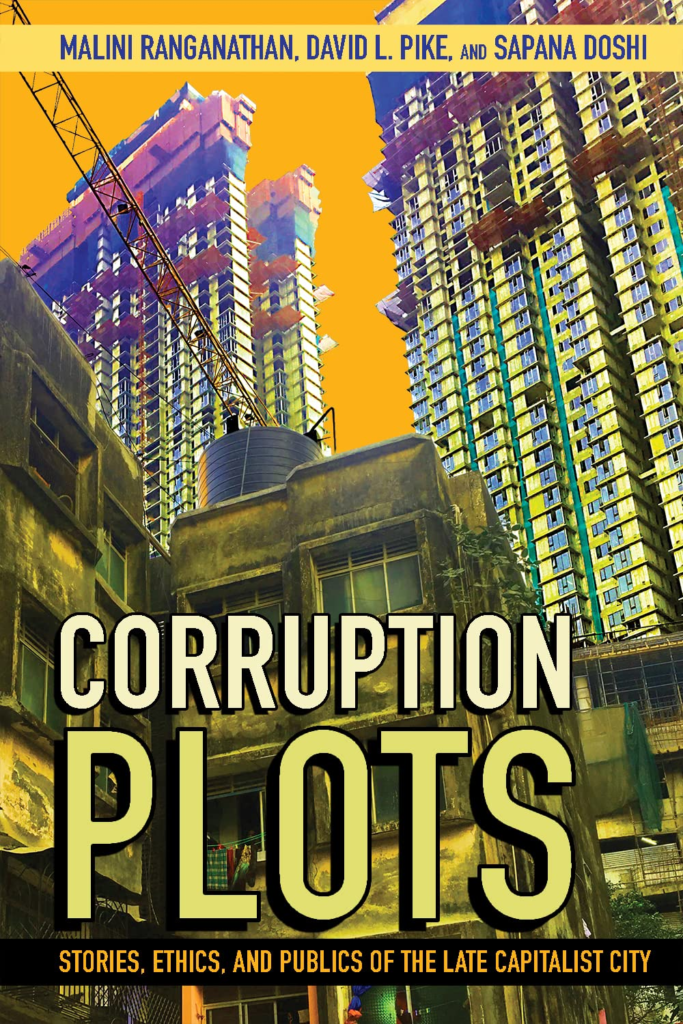
The word corruption is widely and loosely used in common parlance with binary and simplistic plot lines. Corruption Plots: Stories, Ethics, and Publics of the Late Capitalist City by Malini Ranganathan, David L. Pike and Sapana Doshi (published by Cornell University Press in 2023) moving further from perpetrator and victim tropes or even locating corruption in the global South, enquires who has the power to decide if a certain act is an act of corruption or not. In this endeavour, corruption talk, which creates these corruption plots, is employed as a heuristic tool by authors to identify power politics. To map these corruption plots, the authors intertwine insights from ethnographic fieldwork in Mumbai and Bangalore accompanied by a deep reading of world cinema, classics, and contemporary novels. The cities of Mumbai and Bangalore are not mere passive backdrops to their exploration of corruption plots; instead, it is argued that urbanisation and corruption are mutually ‘constituted.’ Embedded in these cities, are sites of corruption. These, as the chapters of the book show comprise slums, multistorey buildings, peripheries, swamplands, infrastructure, and world-class cities – the topos that the book dwells upon.
Corruption plots across these topos are complex, and messy, and lack a protagonist and antagonist akin to those in a film. The book, at its core, resists this temptation to adhere to binaries and posits that corruption is entangled in a complex web of shifting loyalties, dynamic agencies, and grey ethics. In a refreshing departure from the popular, emotionally charged, and preachy take on corruption, the authors provide a mature and measured approach to analysing corruption plots. For instance, by capturing both the economic and bureaucratic powers of a multinational developer; respectability politics of middle-class groups and the ‘urban metis’ (jugaad) of individuals from marginalised social groups who are engaged in land brokering but also in fighting land encroachments. Another illustration is that middle-class housing can be as illegal as the slums; however, the locus of criminalisation and the risks of life and death are often against the lesser privileged groups. Although the text underlines that almost everyone is implicit in corruption, there is a compelling subtextual argument that it is the rich, powerful, and political elites who control the contours of defining corruption.
The authors build their case to argue that corruption plots in the global South can serve as a valuable heuristic for comprehending the workings of corruption worldwide, more specifically in Western countries. The directionality of Western scholars locating corruption in the global South is inverted to highlight the merit of theorising from the South while reconsidering corruption theory. The chapters on peripheries, swamplands, and infrastructure demonstrate the globally networked and interconnected flows of capital, corporate power, and state-led imaginaries, thereby advocating for North-South-connected narratives rather than researching geographies in silos. The book contends that there exist similar patterns of private wealth accumulation, abject inequality, and widespread precarity in both the North and the South. At multiple moments, the chapters highlight the liberal ethics invoked by the global North to locate corruption in the South, thereby emphasising the trajectories of influence. More space and opportunities could have been sought in each of the chapters to further bolster the case for south-to-north learning. Nevertheless, the book provides an exhaustive and compelling analysis of power imbalances in defining corruption using ethnographic evidence.
The book creates a new benchmark for ethnographic narratives. The underlying methodological argument that uni-dimensional plots are misleading, as well as the necessity to embrace multi-voice narratives, have driven the effort to elicit perspectives from real estate agents, street-level bureaucrats, environmentalists, and “one-man armies.” The reader is immediately transported to the field sites with the minute and perceptive observations of micro-yet-invaluable details that are revealed during these interviews. For example, an activist showed coloured pencil boxes that concealed four spy cameras that he used to trap big developers. Across chapters, the rich ethnographic material is interwoven with a broader discourse of cinema, literature, journalism, administrative documents, and academic literature. To give a glimpse, the ethnographic material in the Peripheries chapter is historically, socially, and culturally situated using—a Kannada regional film Ambareesha (2014), a West African film Bamako (2006), a Brazilian film Bacurao (2019), an Argentinianfilm Un Oso Rojo (2002), Anita Nair’s novel Chain of Custody (2016), Paulo Lins’s novel City of God (1997), Agni Sreedhar’s My Days in the Underworld: Rise of the Bangalore Mafia (2013), Scott Carney’s investigative article on (gangster-turned-real estate dealer) Muthhappa Rai, and Michael Goldman’s concept of Speculative Urbanism, all in one chapter. Despite such an overwhelming and diverse set of knowledge sources, the authors make a conscious effort to provide a note of their positionality, privileges, vulnerabilities, and possible biases. Additionally, the book concludes with an honest reflection on the backstage processes of research collaborations across disciplines, ideologies, and positionalities.
In sum, the book is an exceptional resource for ethnographers, urban studies scholars, geographers, cinema and literary critics, civic society activists, and anyone with a keen interest in power, plots, and perspectives pertaining to corruption.
***
Prajwal Nagesh is a Senior Research Associate at the Institute for Social and Economic Change, Bengaluru, India.

[…] Sociology reviewed Corruption Plots by Malini Ranganathan, David L. Pike, & […]